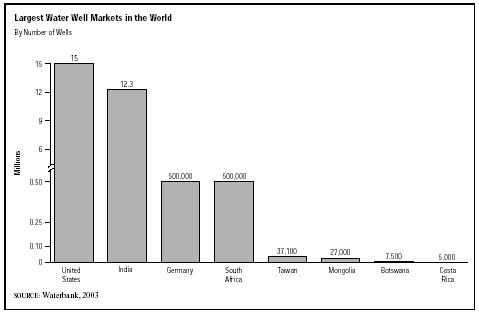SIC 1781
WATER WELL DRILLING
This category covers special trade contractors primarily engaged in water well drilling. Establishments primarily engaged in drilling oil or gas field water intake wells on a contract or fee basis are classified in SIC 1381: Drilling Oil and Gas Wells.
NAICS Code(s)
235810 (Water Well Drilling Contractors)
The U.S. water well drilling industry includes more than 8,000 establishments operating roughly 19,000 drilling rigs in the early 2000s. These establishments had total employment of 25,539 in 2002, according to the U.S. Bureau of Labor Statistics. Average hourly wages for water well drillers totaled $12.77 in 2002.
Establishments engaged in water well drilling in the United States tend to be small, independent contractors. Even the industry leaders tend to be small, seldom generating more than $20 million in annual revenues. Some of the largest companies have diversified into other areas of construction or other types of drilling projects, such as oil, natural gas, and geothermal wells.
The nation's water supply comes from surface sources such as lakes, rivers, and streams, in addition to vast underground aquifers. Groundwater has often been preferred over surface water for use in homes and industry because it is relatively inexpensive to develop and treat, it contains no sediment, its chemical quality remains constant, and facilities to develop it can be situated on small plots of ground. Of the 408 trillion gallons of water consumed daily in the United States in the early 2000s, nearly 20 percent was ground water.

Contractors who drill wells to tap into underground water are largely dependent on new construction. In fact, community water mains and wells for single-family houses account for the vast majority of all business done by this industry. More than 15 million water wells provide 79.4 billion gallons of ground water daily to U.S. residents for community and single-family use, irrigation, livestock, and other agricultural, commercial, and industrial purposes. Irrigation accounted for the largest portion (60 billion gallons) of ground water usage.
Housing starts in the early 2003 remained strong, despite a weakening economy. In fact, housing starts rose to more than 1.8 million in 2003, reaching their highest point since the 1970s. The water well drilling industry was mature and somewhat overserved from both a manufacturing and distribution standpoint. Manufacturers had excess capacity, and distributors were readily available to serve contractors. The environmental business had been the source of most growth for some years. Drillers who offered new and differentiated products were seeing success in their marketing efforts. Increasing emphasis on service and quick responses to customer needs was separating the firms that were growing from those that were merely retaining their market share.
The U.S. drilled roughly 800,000 water wells in the United States each year as of the early 2000s. Michigan was the leading state in terms of number of households served by private water wells, with 1.12 million. Pennsylvania followed with 987,202 households, while North Carolina had 912,113; New York had 824,342; and Florida had 794,557. California housed the largest number of irrigation wells, with 71,544. Texas followed with 57,881, while Nebraska had 57,369, Arkansas had 32,555; Kansas had 19,213; and Florida had 18,993.
Industries engaged in the supply of water are expected to be among the fastest-growing public utilities because of factors such as the nation's expanding population and the increasing number of new housing projects connected to community water sources. The construction industry is expected to grow faster than average for all the nation's industries throughout the early 2000s.
As of 2003 the industry leaders in well drilling were Beylik Drilling Inc., based in Santa Ana, California; Honolulu, Hawaii-based Barnwell Industries Inc., which operates Water Resources International Inc.; and Charles Sargent Irrigation Inc., based in Broken Bow, Nebraska. Other industry leaders included True Geothermal Energy Company, Raba-Kistner Consultants Inc., R. E. Chapman Company, Weeks Drilling and Pump Company Inc., and Grabow Well Drilling Company.
Further Reading
U.S. Department of Labor, Bureau of Labor Statistics. National Industry-Specific Occupational and Wage Estimates. Washington, DC: December 2002. Available from http://www.bls.gov/oes/2001/oesi3_178.htm .
Waterbank. "Frequently Asked Questions." Albuquerque, New Mexico: Westwater Resources, 2003. Available from http://www.waterbank.com/faq1.html .
Comment about this article, ask questions, or add new information about this topic: